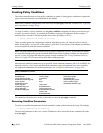
Configuring QoS Creating Policies
OmniSwitch 6600 Family Network Configuration Guide April 2006 page 24-23
4 Use the qos apply command to apply the policy to the configuration. For example:
-> qos apply
Note. (Optional) To verify that the rule has been configured, use the show policy rule command. The
display is similar to the following:
-> show policy rule
Policy From Prec Enabled Inactive Reflexive
my_rule cli 0 Yes Yes No
Cnd/Act: cond5 -> action2
+my_rule5 cli 0 Yes No No
Cnd/Act: cond2 -> pri2
mac1 cli 0 Yes No No
Cnd/Act: dmac1 -> pri2
This command displays information about whether or not the indicated parameter may be used to classify
traffic based on policies that are configured on the switch. For more information about this display, see
“Verifying Policy Configuration” on page 24-30.
An example of how the example configuration commands might display when entered sequentially on the
command line is given here:
-> policy condition cond3 source ip 10.10.2.3
-> policy action action2 priority 7
-> policy rule my_rule condition cond3 action action2
-> qos apply
ASCII-File-Only Syntax
When the policy rule, policy condition, and policy action commands as well as any of the condition
group commands are configured and saved in an ASCII file (typically through the snapshot command),
the commands included in the file will include syntax indicating the command’s origin. The origin speci-
fies where the rule, condition, condition group, or action was created, either an LDAP server or the CLI
(from ldap or from cli). For built-in QoS objects, the syntax displays as from blt. For example:
-> policy action A2 from ldap disposition accept
The from option is configurable (for LDAP or CLI only) on the command line; however, it is not recom-
mended that a QoS object’s origin be modified. The blt keyword indicates built-in; this keyword cannot
be used on the command line. For information about built-in policies and QoS groups, see “How Policies
Are Used” on page 24-4.


















